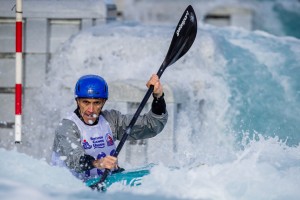The 2013 slalom season
2013 has been an amazing slalom season. I’ve achieved much of what I set out to do and really enjoyed myself along the way. My first slalom career lasted from 1978 to 1990, so I feel immensely appreciative that I’m able to have a second crack at this brilliant sport. Watching the top paddlers fly down the Lee Valley Olympic course during the British Open reminded me of just how cool it is to paddle a kayak at pace down challenging whitewater.
My main goal this year was to race well at the World Masters Games, and this provided a very clear focus for my training and preparation up to the summer. I was pleased to win a silver medal, yet at the same time I would have liked to put in a faster, error free run. But if I reflect on all my races in the season, there wasn’t a single run that I was entirely happy with (although Grandtully was close). This is one of the main appeals of slalom, searching for the elusive ‘ultimate run.’
On the negative side, my paddling has been limited by an old injury to the rotator cuff muscles in my left shoulder. This gets sore if I paddle too much so at times I’ve done less training than I would have liked. There are also the inevitable compromises that come with trying to combine family and work with competitive sport. Although I improved my Division 1 ranking from 25 to 7, with hindsight I can see that competing in more races would have helped.
Winter goals
I’m taking a short break from on water slalom training now, and enjoying the delights of Hurley Weir, one of the best play-boating features you’ll find anywhere. Hopefully I’ll also get out on some rivers over the winter too. Much as I like Lee Valley it’s not the same as a proper river with rocks and trees and a natural riverbank. In terms of my training goals for winter, I’ll be in the gym lifting heavy weights because I want to get stronger as a prelude to getting faster in the boat. I want to learn how to do upstream gates faster so I need to update my technique; “Sweep upstreams” don’t yet come consistently! My default style is to cruise smoothly down the course, so I also want to work on accelerating more in key sections like the exits from eddies.
Managing the gap
Psychologically, people seem to settle on an ‘inner age’ that stays pretty stable – at least that’s what I’m told by my active friends in their 70’s, who claim they feel much younger. So in pursuing my second slalom career, I’ve been reminded of the growing difference between my younger self (stuck in my late 20’s?) and the reality (51 next month). At best, I re-connect with my competitive spirit, feel energized and challenged, and enjoy the buzz of paddling and racing. At worst, harsh reality hits when I see myself on video, or compare my running times with the top racers, and realize that I’m moving so much slower than I imagine!
Managing the gap requires constant attention, holding the dynamic tension between inner and outer identities. I think the trick is to fully ‘own’ the benefits that come with age rather than hanker after eternal youth. After all, maturity brings plenty of advantages in terms of broader experience, greater perspective and (perhaps) a more settled sense of self-confidence. Racing is no longer the most important thing that defines me, making it easier to compete without fear of consequences. At the same time, I enjoy tapping into my younger identity because it keeps me fresh and active. I hope I can continue to manage the gap through paddling, because it seems a relatively healthy way of dealing with the challenges of mid-life. I just hope my friends will be honest with me if I start kidding myself!
What about you? What’s your ‘inner age’? And how does paddling fit in?
Comment here or on the Facebook page



